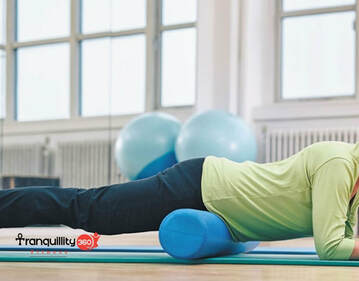 Most people have the advantage of continuing to produce bone-protecting testosterone and androgens throughout life. But the level of the male hormone declines with age and therefore may not be enough to keep bones strong as people hits their later years. Bones maintain their health throughout our lives in a continuous cycle of bone demolition and reconstruction. But as we age from as early as 25 years, the demolition process outpaces bone building. Eventually, human's bones can become thin, porous, weak, and susceptible to fractures. But the good news is that not everyone develops problems with bone health and, importantly, you can slow down the bone-destruction process with exercise. Which type of exercise is best Tranquillity 360 Fitness Personal recommended weight-bearing activities that stimulate bone formation by putting pressure on your bones, especially in your hips and spine, which are common places for fractures. Examples of good weight-bearing exercises are walking, jogging, stair climbing, hiking, and even dancing (Zumba). Add in resistance training a few times per week, too, so you're stimulating bones in your wrists, arms, and lower body. Choose what kind of resistance training fits your life — free weights or resistance bands at home, or machines in the gym. Another type of exercise that can build stronger bones is "impact loading," like skipping rope. You could even combine it with your regular workout by jumping rope for a minute or two as part of your warm-up. Basic Resistance Training Program
0 Comments
 The hamstrings are the unsung heroes of the upper legs. The three muscles in the back of each thigh enable you to bend your knees and pull your legs back as you walk. They also assist the gluteal muscles (or "glutes") in the buttocks — the powerhouses that propel your body forward when you get up from a chair, bound across a room, or climb stairs. The glutes also help you come to a stop from a run or walk and lower your body to sit down or squat. But weak gluteal muscles wind up overburdening the hamstrings. When the glutes are weak, which is common in the age of sitting too much, the hamstrings are continually overworked and overloaded. Sitting down on the job Sitting for long periods weakens the glutes in two ways. One is inactivity: the glutes need to move to stay healthy. The other is a chain reaction caused by sitting too much: the hip flexor muscles in the front of each hip contract and tighten and tell the nerves to inhibit or turn off the muscles that provide the opposite motion — the glutes. This phenomenon is called altered reciprocal inhibition. Weak glutes then force the hamstrings to pick up the slack and do more of the glutes' job. But hamstrings also become tight from too much sitting. Overworked hamstrings When tight hamstrings are forced to work overtime, they're at risk for injury. "They're strained easily, especially if there's a sudden burst of energy — if you have to run after your dog or run across the street at a crosswalk to beat a stoplight. A muscle strain is the stretching or tearing of muscle fibers. Strains range from mild (the tearing of some fibers) to severe (a tear that rips all the way through the muscle fibres and sounds like a pop when it occurs). Strained hamstrings can leave you side-lined with pain and may even require surgery. Aim for teamwork The best way to protect your hamstrings is to keep all your leg muscles healthy and working together, including the glutes and the quadriceps (the muscle group at the front of each thigh). It is recommends getting an evaluation from a physical therapist who can assess your muscles and joint health and develop a workout program tailored to your needs. "We look for balance. We examine the joints where the hamstrings attach — the knee and hip — and we look at the lower back and ankle, to see if things are moving as they should. If there's stiffness in one area, you may be taxing another." Marching orders A hamstring strengthening program involves two approaches: targeting a single muscle group and targeting several muscles at the same time. An example of an exercise for a single muscle group is a hamstring An example of an exercise that works the glutes and hamstrings at the same time is a bridge. To do it, lie on your back with your knees bent and feet flat on the floor, lift your buttocks, hold the position for a few seconds, then lower your buttocks to the floor and repeat the exercise. And another example: Place a lightweight exercise band above your knees or ankles and take steps sideways, backward, or forward to engage the hamstrings, glutes, and quads. Do this exercise only with supervision and arm support nearby, since it may cause you to fall. After strengthening the muscles, remember to stretch them, to keep them long and flexible.  You’ll be getting the best of both worlds when it comes to coconut and protein. Imagine a coconut macaroon mixed with a French macaron and you have this delightful coconut and protein smoothie. One sip of this and you may need to blend up another, stats! Even though this is an amazing drink it’s also packed with great health benefits; The medium chain triglycerides in coconut oil have been shown to increase calories burned over 24 hours by as much as 5%. Bananas are rich in fiber, antioxidants and several nutrients. A medium-sized banana has about 105 calories. Tranquillity 360 Fitness Meal Replacement is pack with 18g of the highest quality protein, Protein is an essential building block of the human body. Ingredients
 Working out regularly will help you hold on to your flexibility, mobility, and independence. And using a simple tool may improve this grip on fitness by priming the muscles and making your workouts more effective. The tool is called a foam roller. It looks like a fat tube or a bolster pillow for a bed. To use it, you slowly roll an area of your body — like your upper back, hips, or calves — back and forth across the top of the roller. "Foam rolling seems to make muscles more receptive to stretching and moving. It's the best thing I've found to make people feel better immediately in the over 15 years I've been doing this Foam rolling benefits Foam rolling helps release tension in the muscles, relieve muscle soreness, and improve flexibility and range of motion. It's not clear exactly how that happens. The current theory is that the sustained pressure on the muscle signals the central nervous system to reduce tension, like the effect of a deep tissue massage. Releasing tension makes tight muscles more receptive to stretching. After foam rolling you get about a 10-minute window of increased flexibility. "That enhances stretching exercises and helps you move better in a workout." Just roll with it A personal trainer or physical therapist can help you determine which muscles will benefit from foam rolling, and then guide you through the process. You'll typically sit or lie on a mat on the floor, place a body part on top of the roller, then move it back and forth until you find a tender spot in your muscle. Hold [on that spot] for 30 to 90 seconds until you get a reduction in tenderness. It's important to breathe deeply during that process, to help relax the muscles. For example, to roll your calf muscle, sit on the mat with your legs in front of you and your hands behind you for support. Place one calf on top of the roller and move your leg back and forth over it. To roll your quadriceps muscles on the front of the thigh, do a modified plank (like a push-up, propped up on your elbows) while lying with your hips and thighs on top of the roller (see photo above). Then move forward and backward over the roller. Who's a candidate for rolling? Bento says most people will benefit from foam rolling as part of a pre- or post-workout routine, or simply as a quick break from sitting. "The hip, shoulder, and ankle muscles can become very tight from long periods of sitting on a couch or at a desk. "Rolling for just a few minutes can help loosen them." |
AuthorsThis blog is updated by Tranquillity 360 fitness personal trainers, as well as other guest bloggers. Archives
July 2021
Categories |

 RSS Feed
RSS Feed